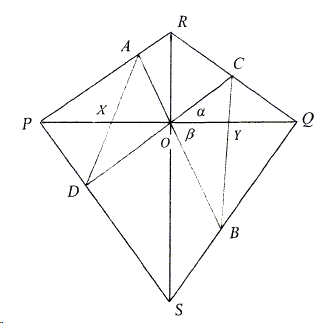Butterfly Trigonometry
Butterflies in quadrilaterals are not much different from butterflies living in circles. And the proof of their existence is readily reduced by affine transformation (shearing) to the case of orthodiagonal quadrilaterals. Two additional (trigonometric) proofs supplied by Sidney Kung (August 13, 2012) establish beyond any doubts the presence of butterflies in orthodiagonal (hence, in other, too) quadrilateral.
Theorem
Through the intersection \(O\) of the mutually perpendicular diagonals \(RS\), \(PQ\) of a convex quadrilateral \(RQSP\), draw two lines \(AB\) and \(CD\) that meet the sides of \(RQSP\) at \(A\), \(B\), \(C\), \(D\). If \(X = AD \cap PQ\), \(Y=CB\cap PQ\), and if \(OP = OQ\), then \(OX = OY\).

The first proof depends on a lemma proved elsewhere
Lemma 1

Let in \(\triangle RST\), \(RU\) be a cevian through vertex \(R\). Introduce angles \(\alpha = \angle SRU\) and \(\beta = \angle URT\). Then
\( \frac{\mbox{sin}(\alpha + \beta)}{RU} = \frac{\mbox{sin}(\alpha)}{RT} + \frac{\mbox{sin}(\beta)}{RS}. \)
Proof 1 of Theorem
Apply the lemma to triangles \(ROQ\), \(SOQ\), and \(BOC):
| (1) | \(\frac{1}{OC}=\frac{\mbox{sin}(\alpha)}{OR}+\frac{\mbox{cos}(\alpha)}{OQ},\) |
| (2) | \(\frac{1}{OB}=\frac{\mbox{sin}(\beta)}{OS}+\frac{\mbox{cos}(\beta)}{OQ},\) |
| (3) | \(\frac{\mbox{sin}(\alpha +\beta)}{OY}=\frac{\mbox{sin}(\beta)}{OC}+\frac{\mbox{sin}(\alpha)}{OB}.\) |
Combining (1)-(3) we obtain
| (4) | \( \frac{\mbox{sin}(\alpha + \beta)}{OY}= \mbox{sin}(\beta)\left(\frac{OQ\cdot \mbox{sin}(\alpha)+OR\cdot \mbox{cos}(\alpha)}{OR\cdot OQ} \right)+ \mbox{sin}(\alpha)\left(\frac{OQ\cdot\mbox{sin}(\beta)+OS\cdot\mbox{cos}(\beta)}{OS\cdot OQ} \right). \) |
Similarly, applying Lemma to triangles \(SOP\), \(ROP\), and \(AOD\), we have
| (5) | \(\frac{1}{OD}=\frac{\mbox{sin}(\alpha)}{OS}+\frac{\mbox{cos}(\alpha)}{OP},\) |
| (6) | \(\frac{1}{OA}=\frac{\mbox{sin}(\beta)}{OR}+\frac{\mbox{cos}(\beta)}{OP},\) |
| (7) | \(\frac{\mbox{sin}(\alpha +\beta)}{OX}=\frac{\mbox{sin}(\beta)}{OD}+\frac{\mbox{sin}(\alpha)}{OA}.\) |
Combining (5)-(7) we obtain
| (8) | \( \frac{\mbox{sin}(\alpha + \beta)}{OX}= \mbox{sin}(\beta)\left(\frac{OP\cdot \mbox{sin}(\alpha)+OS\cdot \mbox{cos}(\alpha)}{OS\cdot OP} \right)+ \mbox{sin}(\alpha)\left(\frac{OP\cdot\mbox{sin}(\beta)+OR\cdot\mbox{cos}(\beta)}{OP\cdot OR} \right). \) |
Remembering that \(OP=OQ\), a comparison of (4) and (8) shows that the right-hand sides are equal, and so are the left-hand sides, implying \(OX=OY\).
Proof 2

Let \(E\) and \(F\) be points symmetric to \(C\) and \(B\) with respect to the line \(RS\). Enlarging the left portion of the diagram

let \(AF\cap OP=Z\). \(F\) being a reflection of \(B\), line \(OP\) bisects \(\angle AOF\). Thus
| (9) | \( \frac{AF}{ZF}=\frac{AO}{OF}. \) |
Note that triangles \(OFD\) and \(OPD\) are co-side (implying they have the same altitude from \(O\)); it follows that
| (10) | \( \frac{DF}{DP}=\frac{1/2\times OD\times OF\times\mbox{sin}(\theta)}{1/2\times OD\times OP\times\mbox{sin}(\alpha)}=\frac{OF\times \mbox{sin}(\theta)}{OP\times\mbox{sin}(\alpha)}. \) |
Similarly, since triangles \(OEP\) and \(OEA\) share side \(OE\),
| (11) | \( \frac{PE}{EA}=\frac{OP\times \mbox{sin}(\alpha)}{OA\times\mbox{sin}(\theta)}. \) |
Multiplying (9), (10), and (11) gives
\( \frac{AZ}{ZF}\frac{DF}{DP}\frac{PE}{EA}=\frac{AO}{OF}\frac{OF}{OP}\frac{OP}{OA}=1. \)
Thus, by the converse of Ceva's Theorem, \(AD\), \(OP\), and \(EF\) are concurrent. Since \(X\) and \(Y\) are on \(PQ\), and \(X\in EF\), \(Y\) must be the symmetric image of \(X\). So, \(OX=OY\).
References
![]()
Butterfly Theorem and Variants
- Butterfly theorem
- 2N-Wing Butterfly Theorem
- Better Butterfly Theorem
- Butterflies in Ellipse
- Butterflies in Hyperbola
- Butterflies in Quadrilaterals and Elsewhere
- Pinning Butterfly on Radical Axes
- Shearing Butterflies in Quadrilaterals
- The Plain Butterfly Theorem
- Two Butterflies Theorem
- Two Butterflies Theorem II
- Two Butterflies Theorem III
- Algebraic proof of the theorem of butterflies in quadrilaterals
- William Wallace's Proof of the Butterfly Theorem
- Butterfly theorem, a Projective Proof
- Areal Butterflies
- Butterflies in Similar Co-axial Conics
- Butterfly Trigonometry
- Butterfly in Kite
- Butterfly with Menelaus
- William Wallace's 1803 Statement of the Butterfly Theorem
- Butterfly in Inscriptible Quadrilateral
- Camouflaged Butterfly
- General Butterfly in Pictures
- Butterfly via Ceva
- Butterfly via the Scale Factor of the Wings
- Butterfly by Midline
- Stathis Koutras' Butterfly
- The Lepidoptera of the Circles
- The Lepidoptera of the Quadrilateral
- The Lepidoptera of the Quadrilateral II
- The Lepidoptera of the Triangle
- Two Butterflies Theorem as a Porism of Cyclic Quadrilaterals
- Two Butterfly Theorems by Sidney Kung
- Butterfly in Complex Numbers
![]()
|Contact| |Front page| |Contents| |Geometry|
Copyright © 1996-2018 Alexander Bogomolny
73602165
